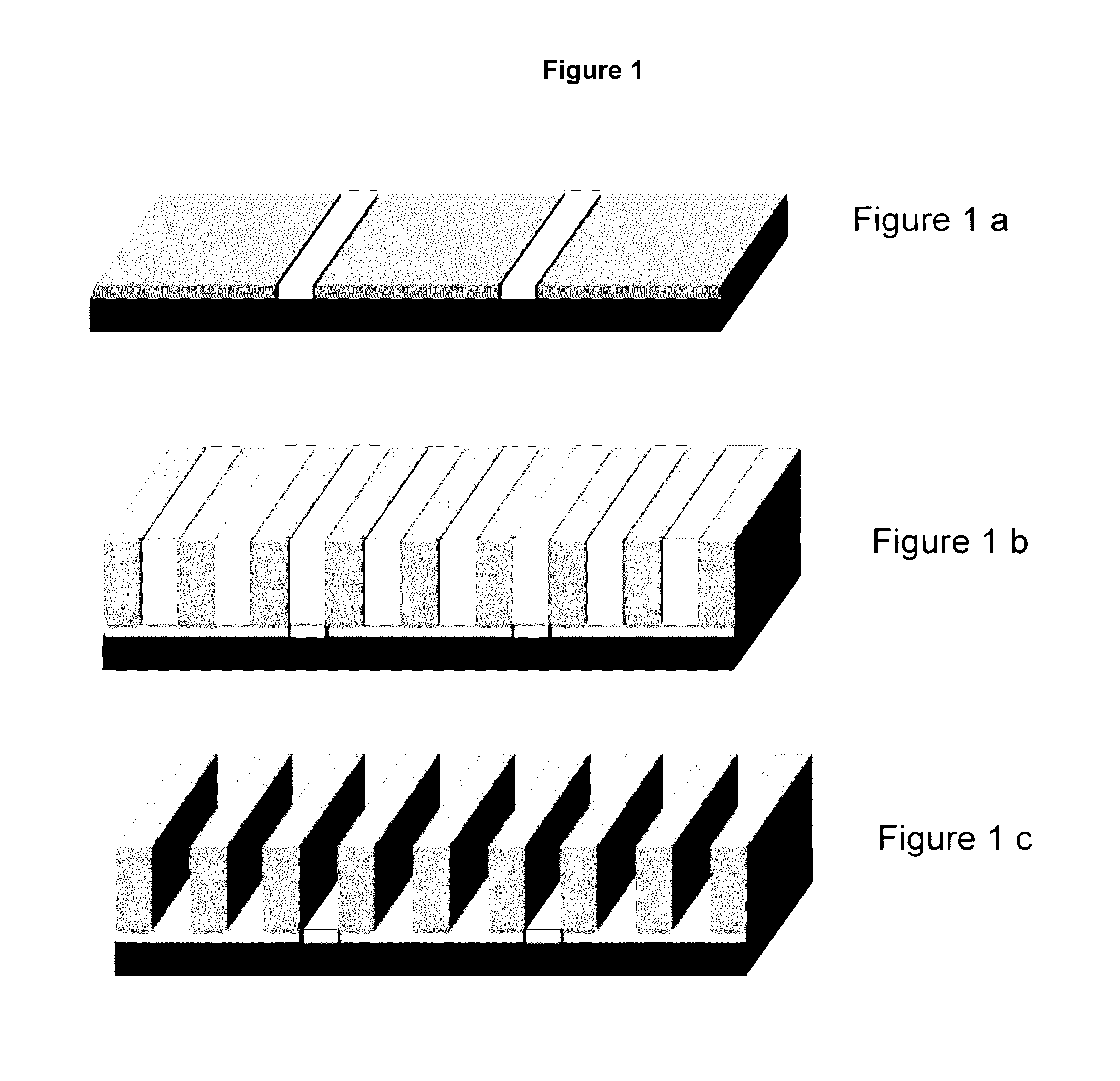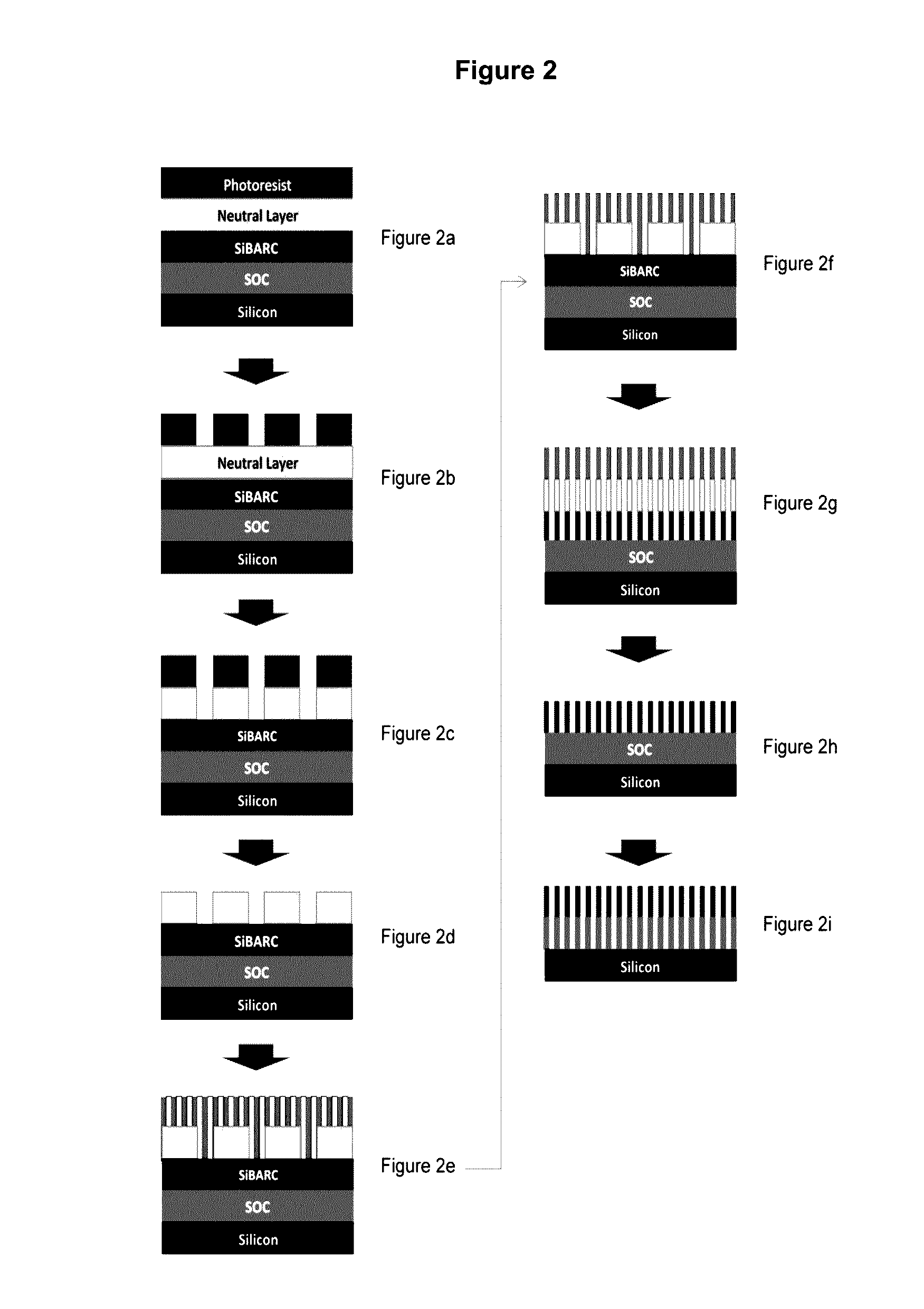Compositions and processes for self-assembly of block copolymers
- Summary
- Abstract
- Description
- Claims
- Application Information
AI Technical Summary
Benefits of technology
Problems solved by technology
Method used
Image
Examples
synthesis example 1
Copolymer of Methyl Styrene, Methyl Methacrylate, and 4-Vinylbenzycylobutene without Graft-Able Benzylic Alcohol End Group Synthesized with AIBN
[0110]A 1000-ml flask equipped with a condenser, temperature controller, heating mantle and mechanical stirrer were set up. 80.0 grams (0.46 moles) of styrene, 30.8 grams (0.31 moles) of methyl methacrylate, 60 grams (0.46 moles) of 4-Vinylbenzocyclobutene, 2.56 grams of Azobisisobutyronitrile (AIBN) initiator and 400 grams of 2-butanone were added to the flask. The mechanical stirrer was turned on and set up at about 120 rpm. The reaction solution was then degassed by vigorously bubbling nitrogen through the solution for about 30 minutes at room temperature. After 30 minutes of degassing the heating mantle was turned on and the temperature controller was set at 80 C, and the stirred reaction mixture was maintained at this temperature for 20 hours. After this time the heating mantle was turned off and the reaction solution was allowed to coo...
synthesis example 2a
Synthesis of Initiator of Structure (5″)
[0111]
[0112](1) A solution was prepared by dissolving with stirring 5.0 g of 4,4′-azobis(4-cyanovaleric acid) in about 100 mL of methanol. To this was added slowly with stirring a solution consisting of an equimolar amount of tetramethylammonium hydroxide pentahydrate in methanol; stirring was continued for 30 min after the addition was complete. The solution was then concentrated at room temperature with a rotary-evaporator, and the residue poured into diethyl ether which upon stirring yielded viscous oil. The oil was turned into a white solid by stirring it in a mixture of diethyl ether and acetone. Drying at room temperature yielded 5.5 g of the ammonium salt of 4,4′-azobis(4-cyanovaleric acid).
[0113](2) A solution was prepared by dissolving 4 g of 4-(chloromethyl)benzyl alcohol in 30 ml of acetone. To this solution was added 5.7 g of sodium iodide dissolved in 25 g acetone. The mixture was stirred at room temperature for 17 hrs. The formed...
synthesis example 2b
Copolymer of Methyl Styrene, Methyl Methacrylate, and 4-Vinylbenzycylobutene Synthesized with Made with Initiator of Structure (5″) Having Graft-Able Benzylic Alcohol End Group of Structure (7)
[0115]
[0116]A 500-ml flask equipped with a condenser, temperature controller, heating mantle and mechanical stirrer was set up. To this flask was added 46.8 grams (0.45 moles) of styrene, 60.2 grams (0.60 moles) of methyl methacrylate, 58.6 grams (0.45 moles) of 4-Vinylbenzocyclobutene, 1.32 grams of Diazo-initiator of structure (5″) made in Synthesis Example 2a and 200 grams of 2-butanone. The mechanical stirrer was then turned on and set up at about 120 rpm. The reaction solution was then degassed by vigorously bubbling nitrogen through the solution for about 30 minutes at room temperature. After this time, the heating mantle was turned on and the temperature controller set at 80° C. and the stirred reaction mixture was maintained at this temperature for 20 hours. After this time the heating...
PUM
| Property | Measurement | Unit |
|---|---|---|
| Temperature | aaaaa | aaaaa |
| Temperature | aaaaa | aaaaa |
| Electrical inductance | aaaaa | aaaaa |
Abstract
Description
Claims
Application Information
 Login to View More
Login to View More - R&D
- Intellectual Property
- Life Sciences
- Materials
- Tech Scout
- Unparalleled Data Quality
- Higher Quality Content
- 60% Fewer Hallucinations
Browse by: Latest US Patents, China's latest patents, Technical Efficacy Thesaurus, Application Domain, Technology Topic, Popular Technical Reports.
© 2025 PatSnap. All rights reserved.Legal|Privacy policy|Modern Slavery Act Transparency Statement|Sitemap|About US| Contact US: help@patsnap.com



